Mapping water insecurity in R with tidycensus
Using the `tidycensus` package to access and visualize American Community Survey (ACS) data.
What's on this page
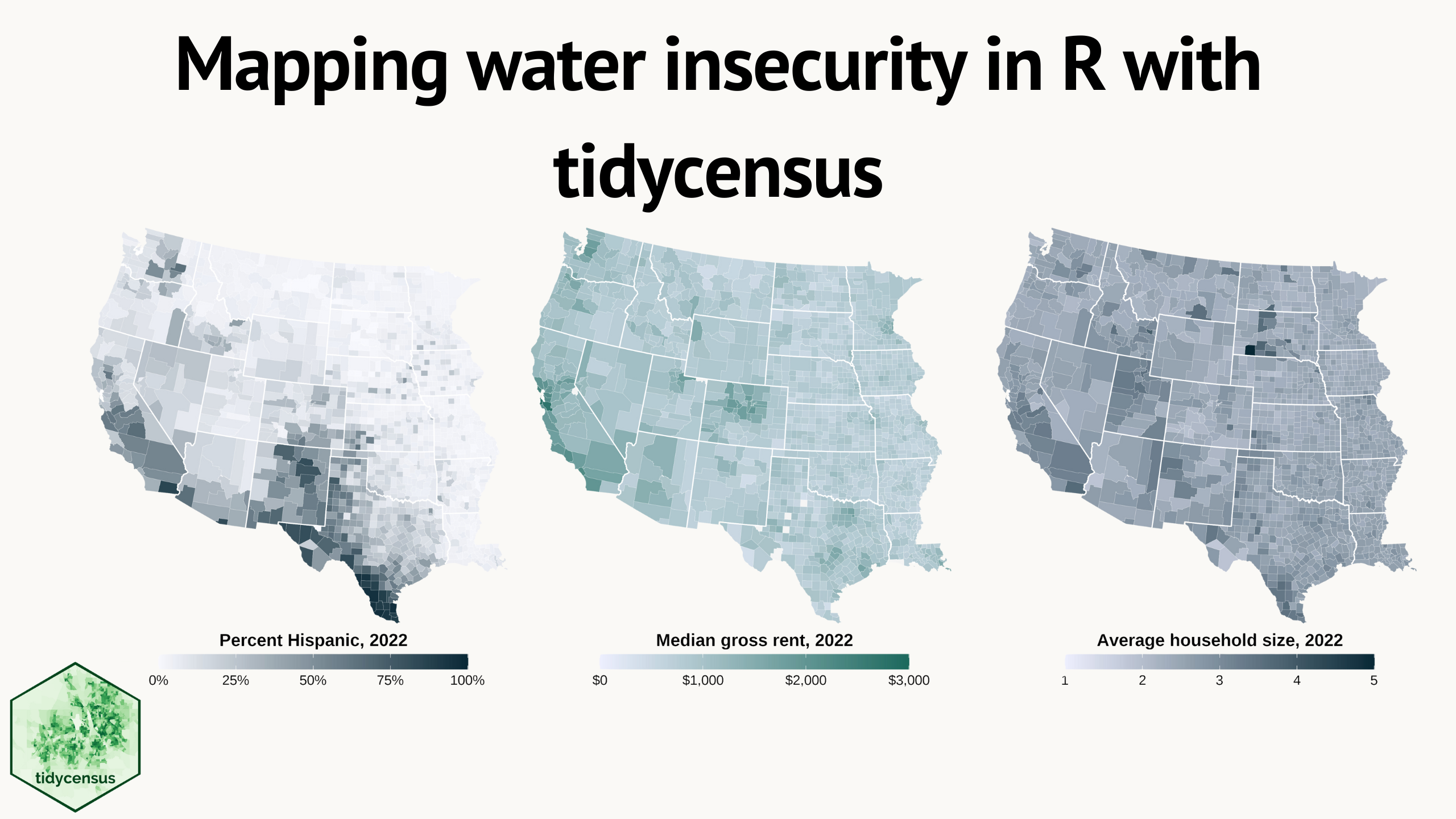
Water insecurity can be influenced by number of social vulnerability indicators—from demographic characteristics to living conditions and socioeconomic status
—that vary spatially across the U.S. This blog shows how the tidycensus
package for R can be used to access U.S. Census Bureau data, including the American Community Surveys, as featured in the “Unequal Access to Water
” data visualization from the USGS Vizlab. It offers reproducible code examples demonstrating use of tidycensus for easy exploration and visualization of social vulnerability indicators in the Western U.S.
Getting started with tidycensus
tidycensus is a package developed by Walker and Herman (2024), that helps R users access U.S. Census Bureau APIs in tidyverse
-friendly formats and sf
-compatible spatial layers. Before you can begin using tidycensus, you’ll need to install the package and set up an API key. Go to http://api.census.gov/data/key_signup.html
for an API key. Then, run the following in the R console:
# Run to install `tidycensus` and additional packages needed in this example
install.packages(c('tidycensus', 'tidyverse', 'sf','janitor', 'tigris',
'rmapshaper', 'showtext', 'scico', 'ggalt', 'plotly', 'scales'))
# Load tidycensus for processing and visualizing data
library(tidycensus)
# Set your Census API key
census_api_key("CENSUS_API_KEY", install = TRUE)
# First time, reload your environment so you can use the key without restarting R.
readRenviron("~/.Renviron")
# You can check your API key with:
Sys.getenv("CENSUS_API_KEY")
Exploring U.S. Census Bureau variables
The U.S. Census Bureau collects data such as population, age, education, and income about the American people. These data are available from a variety of sources such as the Decennial Census , American Community Survey (ACS) , and Household Pulse Survey . The Decennial Census is a complete count of the U.S. population conducted every ten years to allocate congressional representation and federal funding, while the ACS serves as an ongoing annual survey that collects detailed demographic, social, and economic data from a sample of households, for example.
The load_variables()
function lets you access U.S. Census Bureau datasets such the ACS and Decennial Census. The American Community Survey (ACS) data is available for each year since its initiation in 2005. The ACS provides both 1-year estimates (for areas with populations of 65,000 or more) and 5-year estimates (for smaller areas), which cover the following periods:
- 1-Year Estimates: Available annually from 2005 onwards.
- 5-Year Estimates: Available for the periods from 2005-2009 to the current year (e.g., the 2018-2022 estimates were released in December 2023).
Let’s begin by viewing the ACS 1-year estimates variables available for 2023:
# Load American Community Survey 1-year estimates data for 2023
acs_vars <- load_variables(2023, "acs1", cache = TRUE)
# View the first couple rows of data
head(acs_vars)
# A tibble: 6 × 3
# name label concept
# <chr> <chr> <chr>
# 1 B01001A_001 Estimate!!Total: Sex by Age (White Alone)
# 2 B01001A_002 Estimate!!Total:!!Male: Sex by Age (White Alone)
# 3 B01001A_003 Estimate!!Total:!!Male:!!Under 5 years Sex by Age (White Alone)
# 4 B01001A_004 Estimate!!Total:!!Male:!!5 to 9 years Sex by Age (White Alone)
# 5 B01001A_005 Estimate!!Total:!!Male:!!10 to 14 years Sex by Age (White Alone)
# 6 B01001A_006 Estimate!!Total:!!Male:!!15 to 17 years Sex by Age (White Alone)
Once you have identified your variables of interest, you can being pulling the associated data, specifying variables such as year, states of interest, geography (county, census tract, census division, and more). Here, we will pull total counts of owner occupied households lacking plumbing facilities across the Western U.S. (B25049_004
) and total population (B01003_001
) at the county level for 2022 and 2023. Lack of plumbing facilities can be defined as a household that does not have complete plumbing facilities, which are typically defined as:
- Hot and cold running water
- A flush toilet
- A bathtub or shower
With the Census variable identified, we can now begin pulling Census data. To do this we will write our own function to do this. If you are unfamiliar with writing functions, see the Writing functions that work for you and Writing better functions blog posts to get you started.
#' @title Pull U.S. Census Bureau ACS data
#' @description pull census data of interest with set geography, variable of
#' interest, and year.
#' @param geography, the geography of your data
#' @param variable, character string or vector of character strings of variable
#' IDs. tidycensus automatically returns the estimate and the margin of error
#' associated with the variable.
#' @param states, An optional vector of states for which you are requesting
#' data. State names, postal codes, and FIPS codes are accepted. Defaults to
#' NULL.
#' @param year, the year, or endyear, of the ACS sample. 5-year ACS data is
#' available from 2009 through 2021; 1-year ACS data is available from 2005
#' through 2021, with the exception of 2020. Defaults to 2021.
#' @param, survey_var, character, The ACS contains one-year, three-year, and
#' five-year surveys expressed as "acs1", "acs3", and "acs5". The default
#' selection is "acs5." See `?get_acs()` for more information.
#' @param proj, set projection
#' @return a dataframe with census data
library(sf) # For spatial data processing
library(janitor) # For cleaning column names
get_census_data <- function(geography, var_names, states, year, proj, survey_var) {
# Obtain data and feature geometry for ACS data and processing it
df <- get_acs(
geography = geography,
variable = var_names,
state = states,
year = year,
geometry = TRUE,
survey = survey_var) |>
# standardize and clean column names
clean_names() |>
# set projection of data
st_transform(proj)
return(df)
}
# List of states to filter Census data by
western_states <- c('Washington', 'Oregon', 'California', 'Idaho', 'Nevada',
'Utah', 'Arizona', 'Montana', 'Wyoming', 'Colorado',
'New Mexico', 'North Dakota', 'South Dakota', 'Nebraska', 'Kansas',
'Oklahoma', 'Texas', 'Minnesota', 'Iowa', 'Missouri',
'Arkansas', 'Louisiana')
# Define the variable names: total population and plumbing lacking households
# B01003_001: total population, B25049_004: households lacking plumbing
vars <- c("B01003_001", "B25049_004")
# Pull data for 2023 and 2022
western_data_2023 <- get_census_data(
geography = 'county',
var_names = vars,
states = western_states,
year = 2023,
proj = "EPSG:5070",
survey_var = "acs1"
)
western_data_2022 <- get_census_data(
geography = 'county',
var_names = vars,
states = western_states,
year = 2022,
proj = "EPSG:5070",
survey_var = "acs1"
)
You can use get_acs()
for obtaining data and feature geometry for the ACS. Similarly, you can use get_decennial()
to obtain data and feature geometry for the Decennial Census. For the case of this blog, we used a function to pull ACS U.S. Census Bureau data.
Processing U.S. Census Bureau data
The total owner occupied households lacking plumbing facilities across counties the Western U.S. for 2023 and 2022 are contained in the western_data_2023 and western_data_2022 data frames, respectively. The datasets, western_data_2023 and western_data_2022, contain information about counties in the Western U.S., including population numbers, households lacking plumbing, and their geographic boundaries. Each row represents a county, with columns showing the county’s ID (geoid), county name, the type of data (e.g., total population or households lacking plumbing), the estimated value, the margin of error (moe), and the county’s map boundaries (geometry). Let’s now do some processing to get the data in a wide format, create new column names for the Census variables, and calculate the percent of the total county populations lacking plumbing facilities.
library(tidyverse) # For dataframe processing
# Pivot data to wider format for 2023
western_data_2023_wide <- western_data_2023 |>
# new column variable_long based on the value of the variable column
mutate(
variable_long = case_when(
variable == "B01003_001" ~ "total_pop",
variable == "B25049_004" ~ "plumbing",
.default = NA_character_ # In case there are any other variables
)
) |>
select(geoid, name, variable_long, estimate, geometry) |>
pivot_wider(
names_from = variable_long,
values_from = estimate
) |>
# Add a column for percent of population lacking plumbing in 2023
mutate(
percent_lacking_plumbing = (plumbing / total_pop) * 100
)
# Pivot data to wider format for 2022
western_data_2022_wide <- western_data_2022 |>
# new column variable_long based on the value of the variable column
mutate(
variable_long = case_when(
variable == "B01003_001" ~ "total_pop",
variable == "B25049_004" ~ "plumbing",
.default = NA_character_ # In case there are any other variables
)
) |>
select(geoid, name, variable_long, estimate, geometry) |>
pivot_wider(
names_from = variable_long,
values_from = estimate
) |>
# Add a column for percent of population lacking plumbing in 2022
mutate(
percent_lacking_plumbing = (plumbing / total_pop) * 100
)
Visualizing U.S. Census Bureau data with tigris and sf
Let’s plot the data! Using the tigris
package we can directly access TIGER/Line shapefiles
from the U.S. Census Bureau for U.S. political boundaries:
library(tigris) # For downloading and using cartographic boundary shapefiles
library(rmapshaper) # For simplifing spatial objects
library(showtext) # For adding custom fonts
library(scico) # For adding color palettes
western_sf <-
# download a generalized (1:500k) states file
states(cb = TRUE) |>
# set projection
st_transform("EPSG:5070") |>
# standardize column names
clean_names() |>
# filter data for Western states
filter(name %in% western_states) |>
# simplify spatial data
ms_simplify(keep = 0.2)
western_counties_sf <-
# download a generalized (1:500k) counties file
counties(cb = TRUE) |>
# set projection
st_transform("EPSG:5070") |>
# standardize column names
clean_names() |>
# filter data for Western counties
filter(state_name %in% western_states) |>
# simplify spatial data
ms_simplify(keep = 0.2)
# Load custom font for legend title
font_legend <-"Source Sans Pro"
font_add_google(font_legend)
showtext_opts(dpi = 300, regular.wt = 200, bold.wt = 700)
showtext_auto(enable = TRUE)
map_change_plumbing <- function(data, year){
map_chloropleth_change <-
data |> # load the census data
ggplot(
aes(fill = percent_lacking_plumbing) # Set fill variable
) +
geom_sf(
color = "white", # Plot with white boundaries
linewidth = 0.05 # Set the width of the boundary lines
) +
geom_sf(
data = western_sf, # Add state boundaries for overlay
fill = NA, # No fill for this layer
color = "white", # Set the boundary color to white
linewidth = 0.1, # Set the width of the boundary lines
linetype = "solid" # Use solid lines for the boundaries
) +
geom_sf(
data = western_counties_sf, # Add county boundaries for overlay
fill = NA, # No fill for this layer
color = "grey80", # Set the boundary line color to gray
linewidth = 0.09, # Set the width of the boundary lines
linetype = "solid" # Use solid lines for the boundaries
) +
theme_void() + # Remove axis text and labels
theme(
text = element_text(family = font_legend, size = 16), # Custom font
legend.margin = margin(t = 5, b = 2), # Set margins for the legend
legend.position = 'bottom', # Position the legend at the bottom
legend.title.align = 0.5 # Center-align the legend title
) +
guides(
fill = guide_colorbar( # Customize the color bar legend
title.position = "top", # Position the title at the top
# Customize title text
title.theme = element_text(
face = 'bold',
family = font_legend,
size = 16
),
direction = "horizontal", # Orient the color bar horizontally
position = "bottom", # Position the color bar at the bottom
barwidth = 20, # Set the width of the color bar
barheight = 1) # Set the height of the color bar
) +
scale_fill_scico(
name = sprintf("Households lacking plumbing (%s)", year), # Legend title
limits = c(0, 5), # Set the range of values for the fill scale
breaks = c(0, 1, 2, 3, 4, 5), # Set break points for the legend
palette = "lajolla", # Use the "lajolla" palette from `scico`
direction = -1, # Swap "lajolla" palette direction
end = 0.95, # Edit interval within palette to sample colors from
na.value="white", # Assign NA values as white
labels = function(x) paste0(x, "%")) # Paste % labels on legend
return(map_chloropleth_change)
}
# View your maps
map_change_plumbing(data = western_data_2023_wide, year = 2023)
map_change_plumbing(data = western_data_2022_wide, year = 2022)
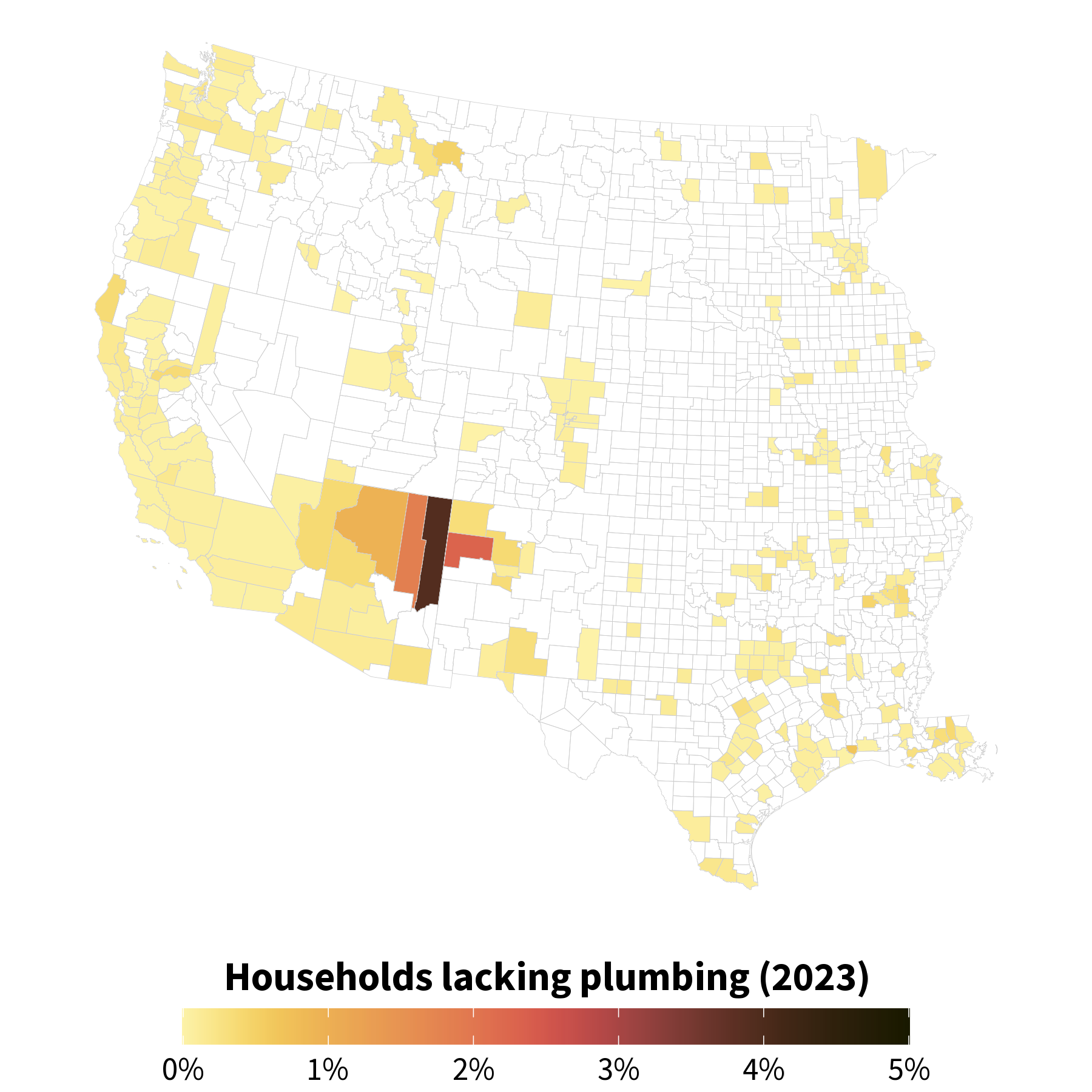
Choropleth map of percent of households lacking plumbing facilities in 2023 across counties in the Western U.S. Counties with the greatest percent of lacking plumbing facilities include Apache County, AZ (3.9%), McKinley County, NM (2.3%), and Navajo County, AZ (1.9%).
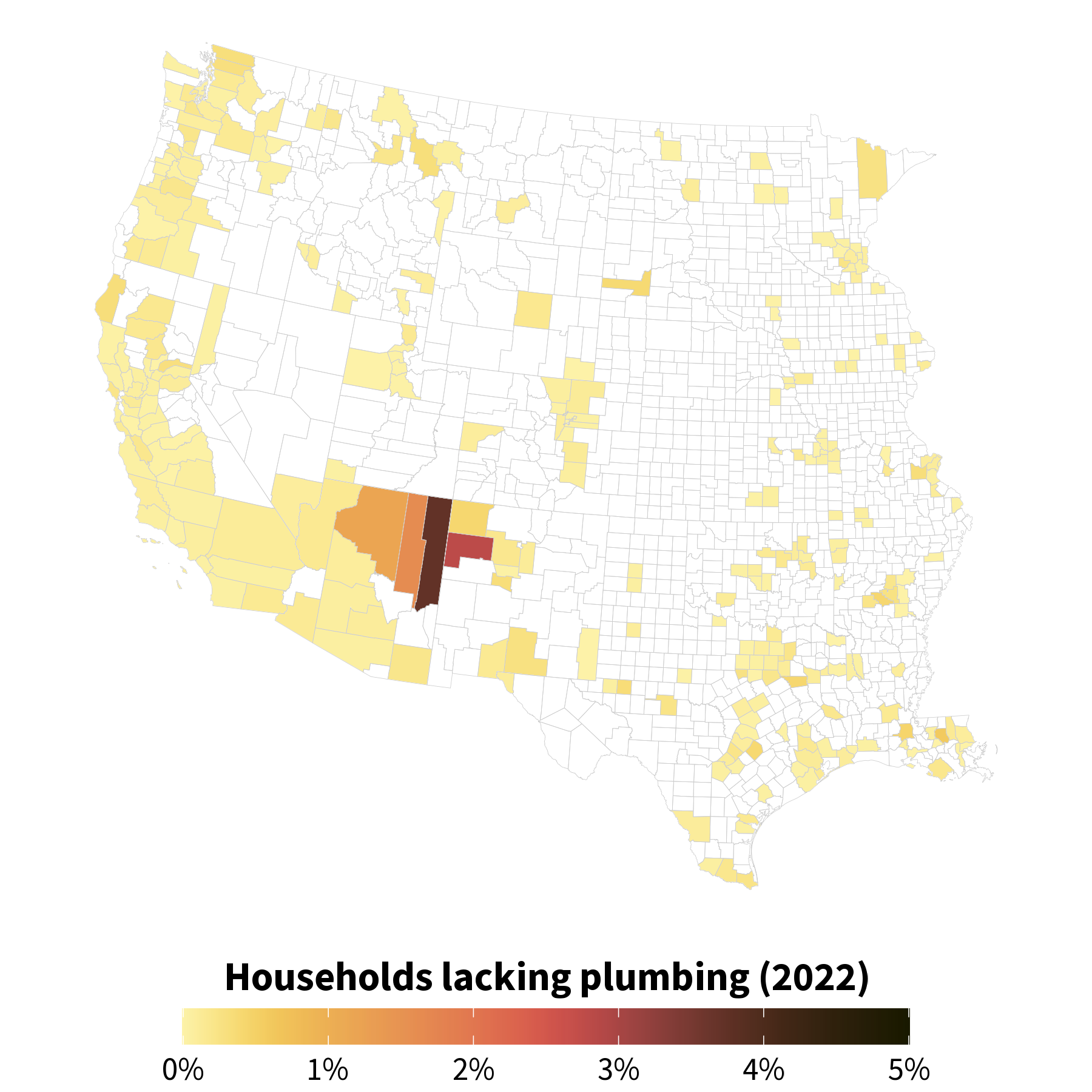
Choropleth map of percent of households lacking plumbing facilities in 2022 across counties in the Western U.S. Counties with the greatest percent of lacking plumbing facilities include Apache County, AZ (3.7%), McKinley County, NM (2.8%), and Navajo County, AZ (1.6%).
View differences in percent plumbing facilties for states of interest
Let’s now take a look certain states in the Western U.S. and how lack of complete indoor plumbing compares between 2022 and 2023 Census data. This county-level figure displays patterns and differences that provide deeper insight into infrastructure disparities and water insecurity across the region.
library(ggalt) # For creating dumbbell charts
plot_dumbbell <- function(data, state_of_interest) {
dumbbell <- ggplot(
data |>
filter(state %in% state_of_interest),
aes(
y = reorder(county, percent_lacking_plumbing_2023)
)
) +
geom_dumbbell(
aes(
x = percent_lacking_plumbing_2022,
xend = percent_lacking_plumbing_2023
),
size = 1.5,
color = "#adadff"
) +
geom_point(
aes(
x = percent_lacking_plumbing_2022,
# Map color to a label
color = "2022"
),
size = 3
) +
geom_point(
aes(
x = percent_lacking_plumbing_2023,
# Map color to a label
color = "2023"
),
size = 3
) +
labs(
title = sprintf(
"Change in incomplete plumbing facilities in %s",
state_of_interest
),
x = "Percent Lacking Plumbing",
y = " ",
# Add legend title
color = "Year"
) +
# Define colors for the legend
scale_color_manual(
values = c("2022" = "#adadff",
"2023" = "#00008B")
) +
theme_minimal(base_size = 10) +
theme(
axis.text.y = element_text(size = 8,
hjust = 1, vjust = 1),
axis.title.x = element_text(vjust = -1),
plot.title = element_text(hjust = 0,
face = "bold",
size = 12),
# Move legend to the top
legend.position = "top",
# Make legend horizontal
legend.direction = "horizontal",
# Remove legend title (optional)
legend.title = element_blank(),
# Adjust margin to bring it closer to the title
legend.margin = margin(t = -5),
# Increase legend text size
legend.text = element_text(size = 10),
legend.key.size = unit(1.5, "lines"),
) +
scale_x_continuous(labels = function(x) paste0(x, "%"))
return(dumbbell)
}
# Call the function with the data and states of interest
plot_dumbbell(data = western_data_2023_2022, state_of_interest = "New Mexico")
plot_dumbbell(data = western_data_2023_2022, state_of_interest = "Arizona")
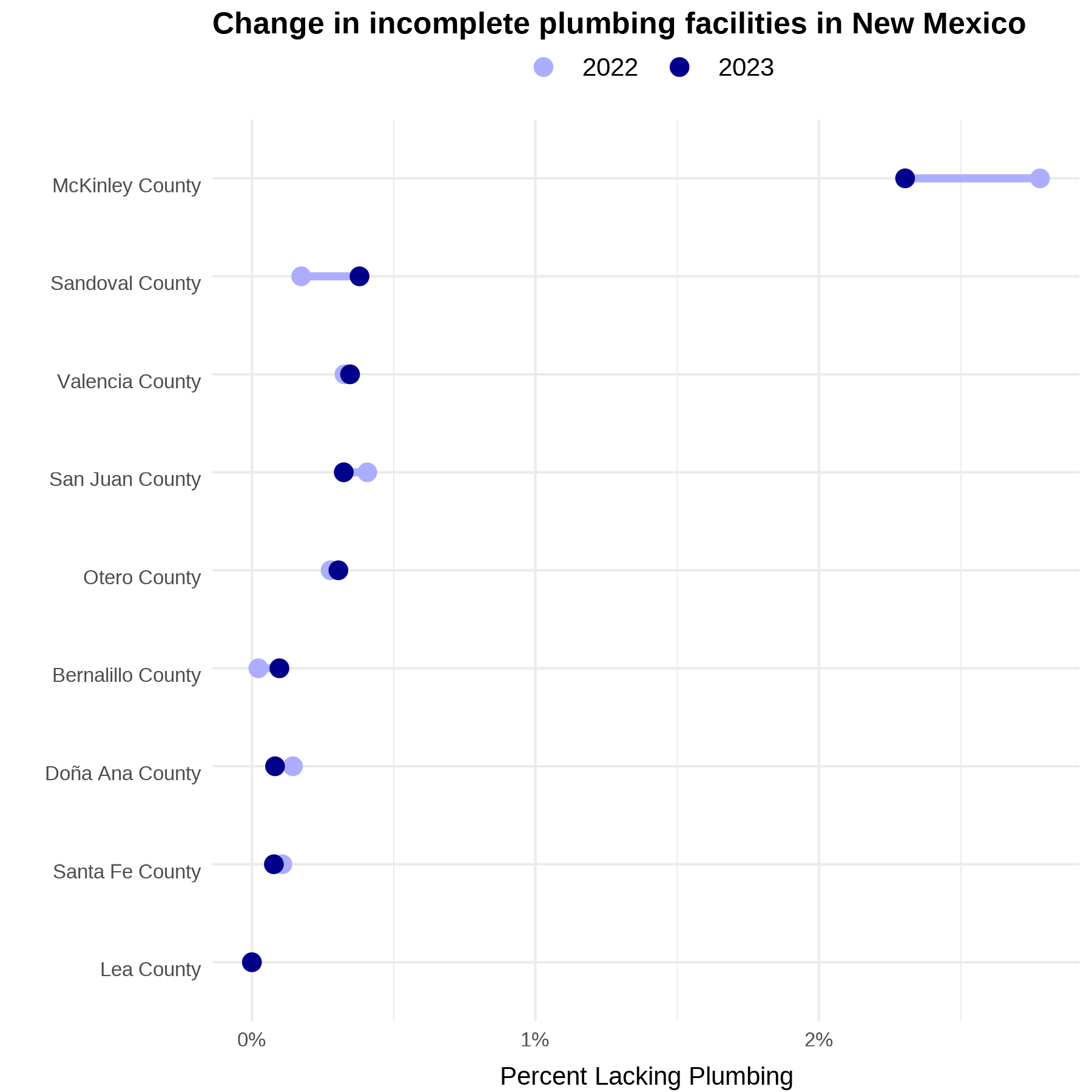
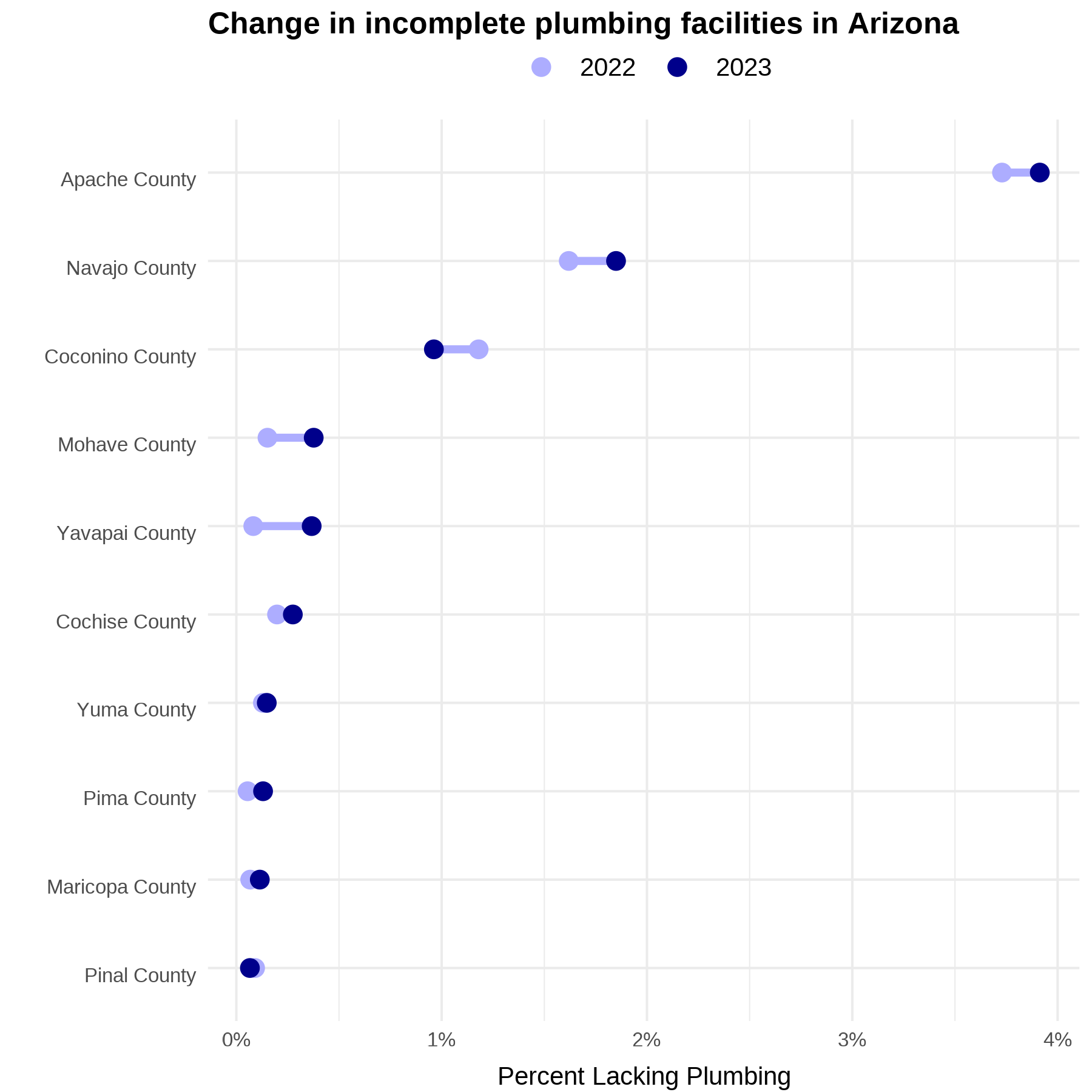
Visualizing total population vs. percent lacking plumbing across counties in the Western U.S.
While the choropleth map gives us a spatial snapshot of where households lack plumbing facilities, it does not provide the full picture. For instance, how population size relates incomplete plumbing. Low levels of incomplete plumbing in a highly populated county could still affect many households, while less populated counties lacking indoor plumbing may represent fewer absolute households.
To explore this let’s plot total population against the percentage of households lacking plumbing using counties in the Western U.S. This scatter plot enables us to identify both highly populated areas that lack plumbing facilities and less well-populated counties with higher relative plumbing insecurity.
library(scales) # For customizing plot labels
library(plotly) # For interactive chart
library(glue) # For pasting expressions
western_data_2023_2022 <- western_data_2023_wide |> # combine 2023 & 2022 data
st_drop_geometry() |> # Remove geometry columns, keeping only attribute data
select( # Select relevant columns
name,
total_pop,
percent_lacking_plumbing
) |>
rename(
percent_lacking_plumbing_2023 = percent_lacking_plumbing,
total_pop_2023 = total_pop
) |>
left_join(
western_data_2022_wide |> # Join with the 2022 data
st_drop_geometry() |> # Remove geometry columns from 2022 data
select( # Select relevant columns from 2022 data
name,
total_pop,
percent_lacking_plumbing
) |>
# Rename columns
rename(percent_lacking_plumbing_2022 = percent_lacking_plumbing,
total_pop_2022 = total_pop),
by = "name" # Specify the joining by county name
) |>
drop_na() |> # Remove rows with any NA values in the data
mutate( # Create new columns to extract state and county names
state = str_extract(name, "(?<=, ).*"), # Extract the state name using regex
county = str_extract(name, ".*(?=, )") # Extract the county name using regex
)
# Transform the 2023 and 2022 data from wide to long format
western_data_2023_2022_long <- western_data_2023_2022 |>
pivot_longer( # Identify columns starting with 'percent_lacking_plumbing_'
cols = starts_with("percent_lacking_plumbing_"),
names_to = "year", # Name the new column for year information
values_to = "percent_lacking_plumbing") |> # Name the new column for plumbing %
mutate(
# Map the year names to numeric values (2023 or 2022)
year = ifelse(year == "percent_lacking_plumbing_2023", 2023, 2022)
) |>
pivot_longer(
cols = starts_with("total_pop_"), # Identify columns starting with 'total_pop_'
names_to = "pop_year", # Name the new column for population year information
values_to = "total_pop" # Name the new column for total population values
) |>
filter(
# Keep rows where the population year matches the plumbing year
(pop_year == "total_pop_2023" & year == 2023) |
(pop_year == "total_pop_2022" & year == 2022)
) |>
select(-pop_year) # Remove the 'pop_year' column, as it's no longer needed
# Create scatter plot
p <- ggplot(
western_data_2023_2022_long,
aes(
x = total_pop,
y = percent_lacking_plumbing,
color = factor(year)
)
) +
geom_point(size = 2, stroke = 0.5, shape = 21, fill = NA, alpha = 0.8) +
labs(
x = "Total Population",
y = "Percent Lacking Plumbing",
color = NULL # Remove legend title
) +
theme_minimal() +
scale_x_continuous(
labels = scales::comma
) +
scale_color_manual(
# Custom colors for 2022 and 2023
values = c("2022" = "#005AB5",
"2023" = "#DC3220")
) +
theme(
axis.text.y = element_text(size = 8,
hjust = 1, vjust = 1),
axis.title.x = element_text(vjust = -1),
axis.title.y = element_text(vjust = 2),
# Move legend to the top
legend.position = "top",
# Make legend horizontal
legend.direction = "horizontal",
# Remove legend title (optional)
legend.title = element_blank(),
# Adjust margin to bring it closer to the title
legend.margin = margin(t = -5),
# Increase legend text size
legend.text = element_text(size = 10),
legend.key.size = unit(1.5, "lines"),
# Plot margin spacing
plot.margin = margin(t = 15, r = 20, b = 15, l = 15, unit = "pt")
)
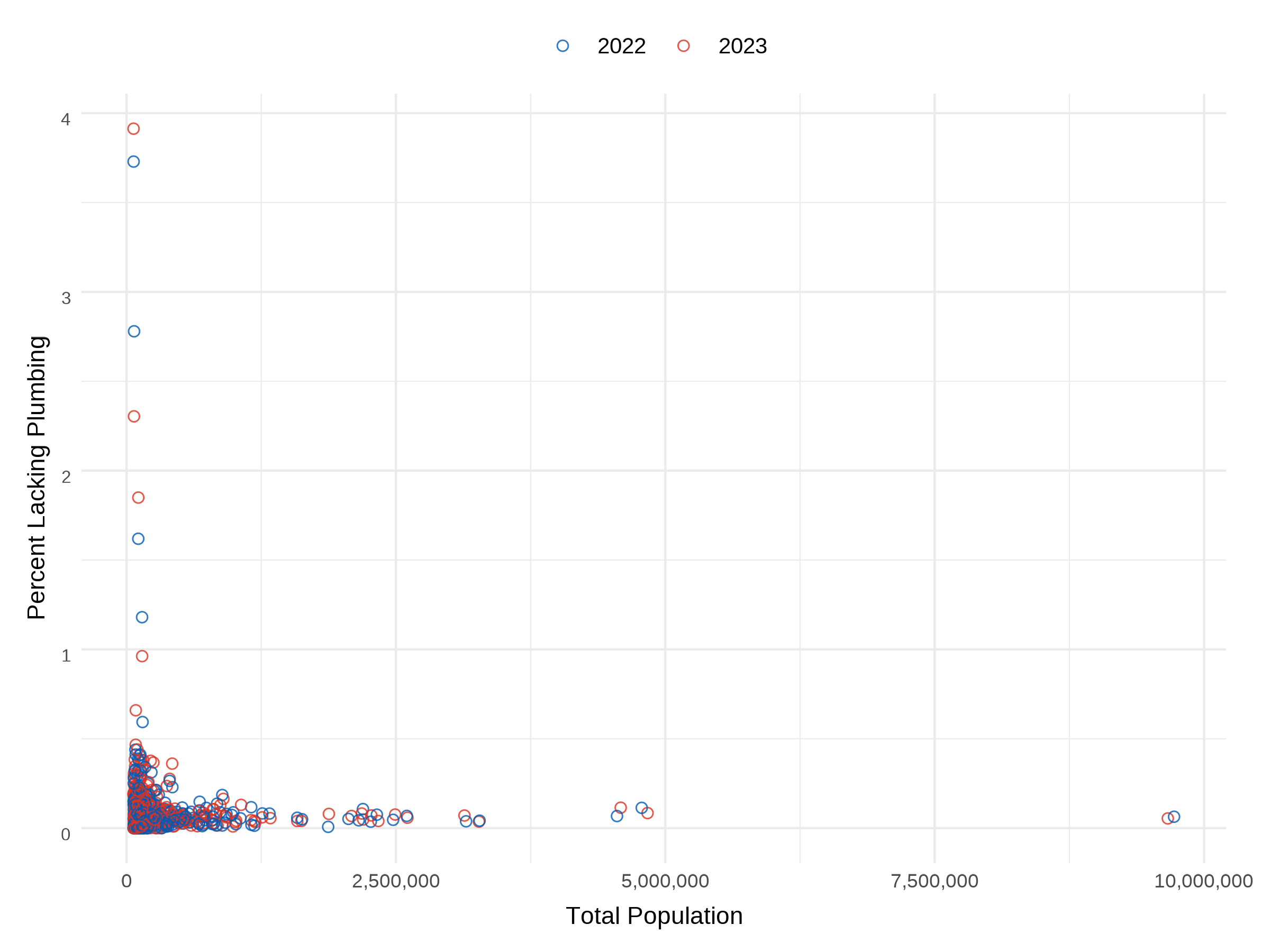
Highlighting use cases associated with water insecurity in the Western U.S.
Using tidycensus, we can make use of U.S. Census Bureau data to plot various variables such as population, age, education, income, and more. With our recent release “Unequal access to water: How societal factors shape vulnerability to water insecurity
”, we highlight various vulnerability indicators across the Western states that are related to water insecurity using the tidycensus package. This website highlights recent research “Social Vulnerability and Water Insecurity in the Western United States: A Systematic Review of Framings, Indicators, and Uncertainty
” that finds certain demographic traits and socioeconomic circumstances, along with increased hazard exposures, make some people more susceptible to water insecurity than others. Specifically, indicators such as household sizes, Hispanic populations, disabled populations, income inequalities, and renter disparities are all factors associated with water insecurity in the Western U.S. For example, literature showed indicators of household size, female-headed households, female population, and percentage of females in the labor force were all predominantly positively related and influential to water insecurity conditions (Drakes et al., 2024)
.
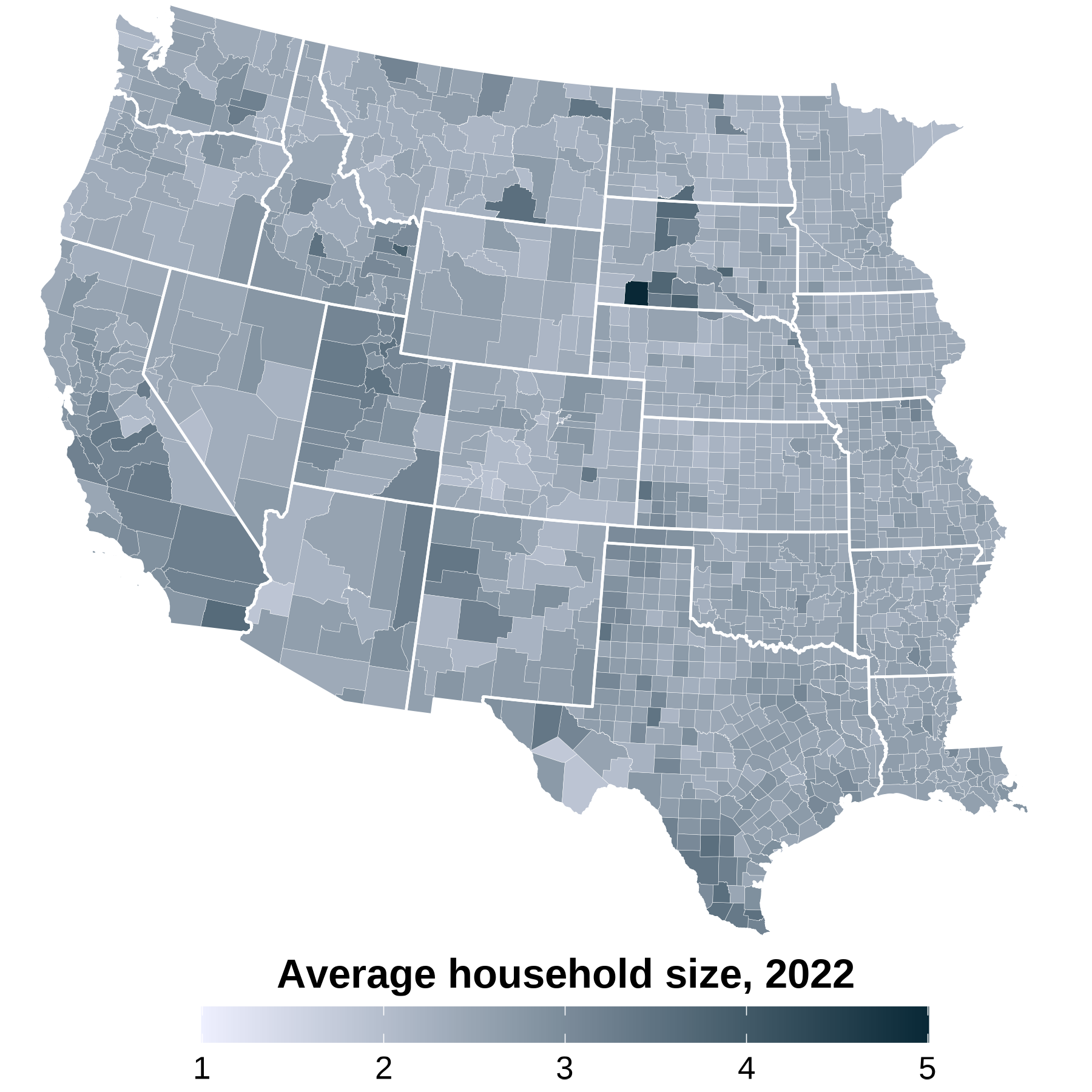
Takeaways
tidycensus allows us to pull, process, and visualize census data from the U.S. Census Bureau’s API, including Decennial Census data and American Community Survey (ACS) data. The package allows us to seamlessly work with associated R packages such as tidyverse, sf, and tigiris as displayed above. By visualizing census data, we can create informative maps and charts that reveal patterns and disparities across different states and regions, helping to inform research, water-resource partners, and the public.
Additional resources
View tidycensus developers’, Kyle Walker and Matt Herman, website
to learn more about additional package functionality and documentation. Check out the book “Analyzing US Census Data: Methods, Maps, and Models in R
”, by Kyle Walker, for additional information on wrangling, modeling, and analyzing U.S. Census data. View our site
to learn more about unequal access to water and how this research can inform more equitable water management practices. Additionally, view the code
used to make our open source, reproducible website here.
References
Azadpour E, Carr AN, Clarke A, Drakes O, Restrepo-Osorio DL, Nell C. 2024. Unequal access to water: How societal factors shape vulnerability to water insecurity. U.S. Geological Survey software release. Reston, VA. https://doi.org/10.5066/P19M9WYT .
Drakes, O., Restrepo-Osorio., D.L., Powlen, K.A. and Hines, M.K., 2024, Social vulnerability and water insecurity in the western United States: A systematic review of framings, indicators, and uncertainty, https://doi.org/10.1029/2023WR036284 .
U.S. Census Bureau, 2022, “Tenure by Plumbing Facilities,” American Community Survey, 1-Year Estimates Detailed Tables, Table B25049, accessed on Nov 27, 2024, https://data.census.gov/table?q=B25049&y=2022 .
U.S. Census Bureau, 2022, “Total Population,” American Community Survey, 1-Year Estimates Detailed Tables, Table B01003, accessed on Nov 27, 2024, https://data.census.gov/table?q=B01003&y=2022 .
U.S. Census Bureau, 2023, “Tenure by Plumbing Facilities,” American Community Survey, 1-Year Estimates Detailed Tables, Table B25049, accessed on Nov 27, 2024, https://data.census.gov/table?q=B25049&y=2023 .
U.S. Census Bureau, 2023, “Total Population,” American Community Survey, 1-Year Estimates Detailed Tables, Table B01003, accessed on Nov 27, 2024, https://data.census.gov/table?q=B01003&y=2023 .
Walker K and Herman M. 2024. tidycensus: Load US Census Boundary and Attribute Data as “tidyverse” and “sf”-Ready Data Frames. R package version 1.6.5, https://walker-data.com/tidycensus/ .
Any use of trade, firm, or product names is for descriptive purposes only and does not imply endorsement by the U.S. Government.
Related Posts
Charting 'tidycensus' data with R
June 24, 2025
In January, 2025, the organizers of the tidytuesday challenge highlighted data that were featured in a previous blog post and data visualization website . Some of us in the USGS Vizlab wanted to participate by creating a series of data visualizations showing these data, specifically the metric “households lacking plumbing.” This blog highlights our data visualizations inspired by the tidytuesday challenge as well as the code we used to create them, based on our previous software release on GitHub .
Easy hydrology mapping with nhdplusTools, geoconnex, and ggplot2
November 28, 2025

Go from hard-to-read default visuals to easy-to-read river maps in a few easy steps!
Reproducible Data Science in R: Flexible functions using tidy evaluation
December 17, 2024
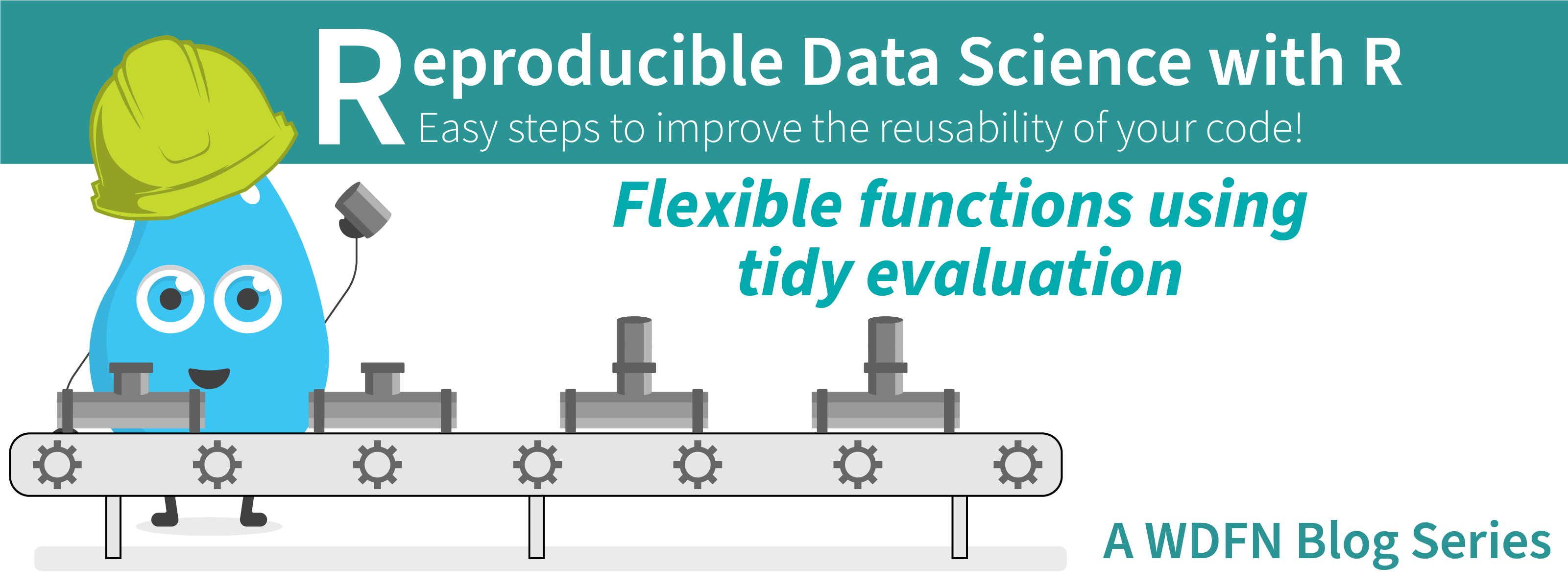
Overview
This blog post is part of a series that works up from functional programming foundations through the use of the targets R package to create efficient, reproducible data workflows.
The Hydro Network-Linked Data Index
November 2, 2020
Introduction
updated 11-2-2020 after updates described here .
updated 9-20-2024 when the NLDI moved from labs.waterdata.usgs.gov to api.water.usgs.gov/nldi/
The Hydro Network-Linked Data Index (NLDI) is a system that can index data to NHDPlus V2 catchments and offers a search service to discover indexed information. Data linked to the NLDI includes active NWIS stream gages , water quality portal sites , and outlets of HUC12 watersheds . The NLDI is a core product of the Internet of Water and is being developed as an open source project. .
Reproducible Data Science in R: Writing functions that work for you
May 14, 2024
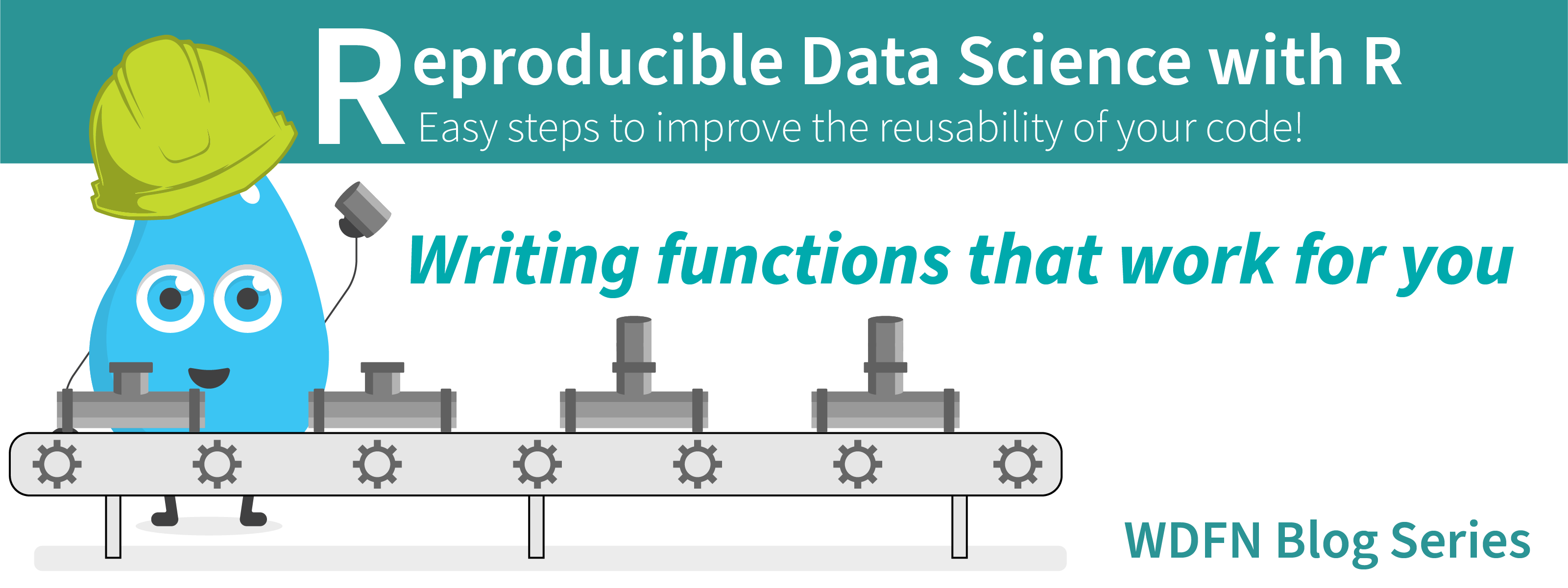
Overview
This blog post is part of a series that works up from functional programming foundations through the use of the targets R package to create efficient, reproducible data workflows.

